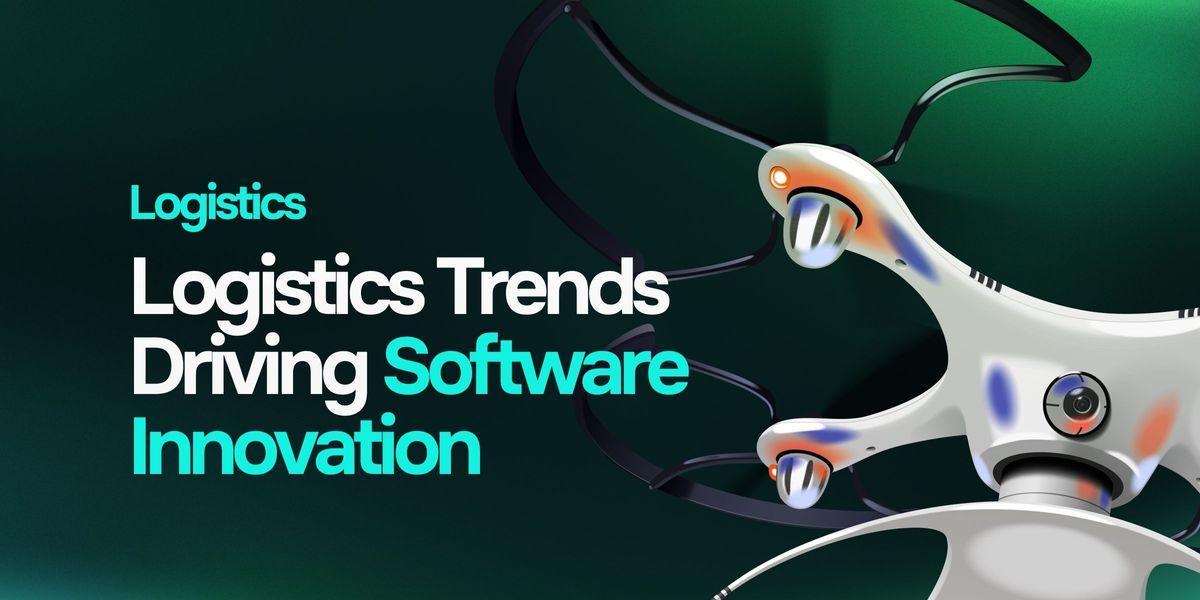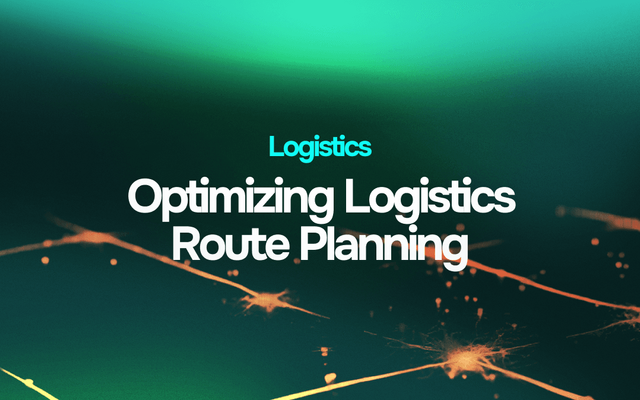
You've seen it before—logistics teams scrambling to keep up with unexpected surges in demand. Warehouses overflowing with inventory they can't track. Delivery drivers are stuck in traffic while customers flood support lines asking, "Where's my package?"
It's not just frustrating—it's costing real money. And the companies that survive aren't just working harder; they're working smarter by leveraging the right technology at the right time.
But here's the problem: logistics isn't standing still. What worked yesterday might be obsolete tomorrow. And if your software solutions aren't keeping pace with emerging logistics industry trends, you're already falling behind.
This article breaks down the key trends reshaping logistics operations and examines how they're driving innovation in the software that powers modern supply chains. No fluff, just practical insights on what's changing and why it matters.

Why Logistics Software Development Matters More Than Ever
The logistics sector is in the middle of a massive transformation. With the industry valued at over USD 11 trillion in 2025, analysts project explosive growth to USD 23.14 trillion by 2034, representing an 8.36% annual growth rate that reflects the sector's critical importance to the global economy.
Global supply chains are becoming more complex. Customer expectations are reaching all-time highs. And the margin for error? It's practically disappearing.
Understanding current trends in logistics isn't just academic—it's survival. Companies that anticipate and adapt to these shifts gain a critical edge over competitors still relying on outdated methods and systems.
These changes create both headaches and opportunities for software developers tasked with building solutions that actually work in today's complex logistics operations. Let's be honest: yesterday's software simply won't cut it anymore.
The most successful logistics operations are those that recognize one fundamental truth: the right software doesn't just support logistics—it becomes the backbone that makes innovation possible in the first place.
Key Emerging Logistics Industry Trends Driving Software Innovation
The logistics world is changing fast, and software must change with it. Let's look at the specific trends that are reshaping not just how goods move, but how the software supporting that movement needs to function.
Each of these trends creates distinct requirements for software developers who need to build systems that don't just work today but can adapt to tomorrow's challenges as well.
Automation and Robotics in the Logistics Industry Trends
Warehouse robots. Autonomous trucks. Drone deliveries. They're not just cool tech demos anymore—they're becoming standard in advanced logistics operations. In fact, there are predictions that by 2026, around 75% of large enterprises will have integrated some form of intralogistics smart robots into their warehouse workflow, signaling rapid adoption across the industry.
But here's what many miss: these physical technologies are useless without sophisticated software systems controlling them. The real innovation isn't just the robot; it's the brain behind it.
Behind those smoothly gliding robots is a complex orchestration system handling thousands of decisions per second. When a human picker calls in sick, the system automatically redistributes tasks. When a conveyor belt slows down, it recalculates paths instantly.
Software developers are now building:
Real-time control systems that coordinate multiple automated elements simultaneously
Integration platforms that allow robots from different manufacturers to work together
Digital twins that simulate physical operations before deploying changes
Companies investing heavily in automation often discover an uncomfortable truth: the hardware is actually the easy part. The real challenge is creating software flexible enough to adapt as business needs change.
The winners in this space aren't just buying robots—they're investing in software that maximizes those robots' efficiency, making automation truly worth the investment.

IoT and Real-Time Tracking: When "Good Enough" No Longer Is
Remember when knowing a package would arrive "sometime Tuesday" was acceptable? Those days are gone. Customers now expect to know exactly where their items are at all times, and logistics providers need that same visibility across their entire operation.
The explosion of IoT devices in logistics has created mountains of valuable data, but also a serious challenge: how to collect, process, and actually use all that information. For example, the average U.S. retailer’s inventory accuracy rate is only 65%, but IoT tracking technologies like RFID can increase that accuracy to 98%, dramatically reducing misplaced stock and improving overall efficiency.
Consider a temperature-sensitive pharmaceutical shipment facing a cold chain breach. Modern IoT systems don't just record the problem—they trigger immediate notifications, reroute the shipment, and document the incident for regulatory compliance.
This trend demands software that can:
Process massive data streams from thousands of connected devices
Provide meaningful visualizations that highlight exceptions, not just data points
Make decisions at the edge when connectivity isn't reliable
The technical challenges are substantial. Network limitations, battery constraints, and intermittent connectivity all create obstacles that sophisticated software must overcome.
The companies getting this right aren't just tracking more things—they're extracting actually useful insights from that tracking data and acting on them faster than competitors.
AI and Predictive Analytics in Logistics: From Reactive to Proactive
Logistics has traditionally been reactive: problems happen, then solutions are found. That's changing as AI and predictive analytics finally deliver on their promise.
Early adopters of AI in logistics have been able to reduce their logistics costs by 15%, demonstrating tangible benefits from smarter automation and forecasting. Moreover, it is estimated that by integrating AI into their processes, logistics companies will generate between $1.3 and $2 trillion in economic value each year over the next 20 years, highlighting the massive potential impact of these technologies on the industry.
Forward-thinking logistics operations now use AI to:
Forecast demand spikes before they happen
Optimize delivery routes based on dozens of variables
Predict maintenance needs before equipment fails
Identify potential supply chain disruptions days or weeks in advance
What makes these capabilities powerful is their ability to learn over time. When a delivery takes longer than predicted, the system notes the discrepancy and adjusts future predictions accordingly, creating a virtuous cycle of increasing accuracy.
The software powering these capabilities isn't simple. It requires:
Machine learning models tailored specifically to logistics problems
Systems that improve their predictions over time
Interfaces that make AI recommendations understandable to humans when making decisions
The best implementations don't just make predictions—they explain them, building trust with the humans who oversee the system.
This isn't about replacing human judgment—it's about giving logistics professionals better information to make smarter decisions faster than ever before.
Sustainability and Green Logistics Trend: No Longer Optional
Let's be blunt: sustainability in logistics isn't just about looking good in CSR reports anymore. It's becoming a business imperative driven by regulations, customer demands, and simple economics.
Emerging trends in logistics increasingly focus on environmental impact, creating demand for software that can:
Optimize routes and loads to minimize fuel consumption
Track and report carbon emissions across complex supply chains
Model scenarios for reducing environmental impact while maintaining service levels
Verify sustainability claims with hard data
The technical complexity shouldn't be underestimated. Calculating the carbon footprint of a single shipment requires data from dozens of sources—from vehicle fuel efficiency to warehouse energy sources.
What's interesting is how sustainability goals often align with cost savings. When routing software minimizes miles driven, it reduces both fuel costs and carbon emissions. When inventory software reduces overstock, it saves warehouse space and prevents waste.
The most effective green logistics initiatives are powered by software that makes sustainability measurable, manageable, and—importantly—profitable rather than just a cost center.
Blockchain for Supply Chain Transparency: Beyond the Hype
After years of inflated expectations, blockchain is finding its actual practical applications in logistics, particularly in areas where trust and transparency are essential.
The technology is now being used for:
Verifying product authenticity through the supply chain
Creating immutable records of temperature-sensitive shipments
Streamlining customs documentation for international shipments
Enabling instant payments triggered by verified delivery events
What's changed is the focus on practical, targeted implementations rather than rebuilding entire supply chains on blockchain. Companies are identifying specific pain points where trust is critical and applying blockchain selectively to those challenges.
For software developers, this creates new challenges around integrating with existing systems, managing performance implications of distributed ledgers, and creating interfaces that hide blockchain complexity.
The best implementations don't force users to understand the underlying technology. The warehouse worker scanning a pallet doesn't need to know they're creating an immutable record—they just need a scanner that works reliably.
The companies succeeding with blockchain aren't using it because it's trendy—they're applying it specifically to problems where its unique properties solve real business issues.

E-commerce and Last-Mile Delivery: Where the Rubber Meets the Road
The continued growth of e-commerce has made last-mile delivery both more important and more challenging than ever before. It's often the most expensive, least efficient part of the logistics process—and the one customers care about most.
What makes the last mile challenging is its resistance to standardization. Urban deliveries differ from rural ones. B2B requires different protocols than B2C. Packages, meals, and groceries each have unique constraints. Software needs flexibility while still providing consistent tracking.
This reality is driving innovation in:
Dynamic routing software that adjusts in real-time to traffic and other conditions
Customer communication platforms that provide unprecedented visibility
Delivery management systems that optimize for both cost and customer satisfaction
Software supporting alternative delivery models like pickup lockers and crowdsourced delivery
The customer experience aspect can't be overlooked. When delivery software allows a customer to update preferences mid-shipment or communicate with the driver, it doesn't just improve satisfaction—it reduces costly failed deliveries.
The most successful last-mile operations aren't just focused on moving packages faster—they're using software to fundamentally rethink how the final delivery process works.
The Integration Challenge Across Logistics Trends
One thread connects all these logistics trends: the need for integration. Standalone solutions don't cut it anymore.
The modern logistics technology stack requires:
Breaking Down Data Silos
Too many logistics operations still struggle with information trapped in isolated systems. Order management doesn't talk to warehouse management. Transportation management doesn't connect with customer service.
The result? Duplication, errors, and countless hours wasted manually transferring information between systems.
Software developers are now focusing on API-first development that enables easier system connections, middleware specifically designed for logistics data exchange, and integration platforms that connect legacy systems with newer technologies.
The companies gaining an edge aren't just implementing new point solutions—they're ensuring all their systems work together as a cohesive whole.
Building Resilient Systems
If 2020-2023 taught the logistics industry anything, it's that disruption is inevitable. Software solutions need to be as adaptable as the organizations they support.
This means developing systems that can scale up or down based on demand fluctuations, architectures that remain functional even when parts of the network are down, and contingency capabilities that automatically activate when primary systems fail.
Resilience isn't a feature—it's becoming the foundation of all serious logistics software.
Preparing for What's Next: Anticipating Emerging Trends in Logistics
The logistics industry will continue to transform. Companies that thrive won't just react to changes—they'll anticipate them.
This means investing in flexible technology foundations that can adapt to new trends in logistics, building internal capabilities to evaluate and implement emerging technologies, and developing partnerships with software providers focused on logistics innovation.
The winners won't necessarily be the biggest or the richest—they'll be the organizations that best combine technological capability with logistics expertise.
As these logistics industry trends accelerate, one thing becomes clear: the line between logistics companies and technology companies is blurring. The most successful organizations will be excellent at both moving physical goods and managing the digital systems that make that movement possible.
The future belongs to those who recognize that in modern logistics, the right software isn't just a tool—it's the competitive advantage that makes everything else possible.







